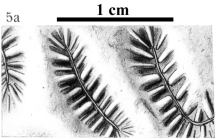Scleractinia taxon details
Placogyra Koby, 1904 †
1438025 (urn:lsid:marinespecies.org:taxname:1438025)
accepted
Genus
Placogyra felixi Koby, 1904 † (type by monotypy)
- Species Placogyra felixi Koby, 1904 †
- Species Placogyra hykeli Eliášová, 1973 †
marine, fresh, terrestrial
fossil only
Koby F. (1904-1905). Polypiers du Jurassique supérieur. Description de la faune jurassique du Portugal. <em>Commission du Service géologique du Portugal, Lisbonne, 1-145, pls. 1-30.</em> [details]
Description Massive meandroid corallum with corallites in series produced by intratentacular increase or isolated corallites....
Description Massive meandroid corallum with corallites in series produced by intratentacular increase or isolated corallites. Externally covered by a granulated tectura. Highly variable collines: tectiform, tholiform or depressed. If present, the peritheca is narrow. Radial elements are compact, free, straight, bicuneiform costosepta. They are alternately thick and thin. Inner edge of primary septa with T-form enlargements, tertiary septa attenuated. Apophysal septa and lonsdaleoid septa exist. No palis. Rhipidogyrid microstructure. Strong bilateral symmetry. Endotheca present. Columella lamellar, synapticulae absent but tigella possibly present in depth between primary septa and the columella. Wall probably septoparathecal and thickened in stereozone. [details]
Hoeksema, B. W.; Cairns, S. (2025). World List of Scleractinia. Placogyra Koby, 1904 †. Accessed at: https://www.marinespecies.org/scleractinia/aphia.php?p=taxdetails&id=1438025 on 2025-05-08
Date
action
by
original description
Koby F. (1904-1905). Polypiers du Jurassique supérieur. Description de la faune jurassique du Portugal. <em>Commission du Service géologique du Portugal, Lisbonne, 1-145, pls. 1-30.</em> [details]
basis of record Cairns, S.D., R. Baron-Szabo, A.F. Budd, B. Lathuilière, E. Roniewicz, J. Stolarski & K.G. Johnson. (2010). Corallosphere. , available online at http://www.corallosphere.org [details]
additional source Kołodziej B. (2003). Scleractinian corals of suborders Pachythecaliina and Rhipidogyrina: discussion on similarities and description of species from Stramberk-type limestones, Polish Outer Carpathians. <em>Annales Societatis Geologorum Poloniae.</em> 73(3): 193-217. [details]
additional source Eliášová H. (1973). Sous-famille Rhipidogyrinae Koby, 1905 (Hexacorallia) des calcaires de de Stramberk (Tithonien, Tchecoslovaquie). <em>Časopis pro Mineralogii a Geologii.</em> 18(3): 267-287, pls. 1-14. [details]
basis of record Cairns, S.D., R. Baron-Szabo, A.F. Budd, B. Lathuilière, E. Roniewicz, J. Stolarski & K.G. Johnson. (2010). Corallosphere. , available online at http://www.corallosphere.org [details]
additional source Kołodziej B. (2003). Scleractinian corals of suborders Pachythecaliina and Rhipidogyrina: discussion on similarities and description of species from Stramberk-type limestones, Polish Outer Carpathians. <em>Annales Societatis Geologorum Poloniae.</em> 73(3): 193-217. [details]
additional source Eliášová H. (1973). Sous-famille Rhipidogyrinae Koby, 1905 (Hexacorallia) des calcaires de de Stramberk (Tithonien, Tchecoslovaquie). <em>Časopis pro Mineralogii a Geologii.</em> 18(3): 267-287, pls. 1-14. [details]
 Present
Present  Inaccurate
Inaccurate  Introduced: alien
Introduced: alien  Containing type locality
Containing type locality
From editor or global species database
Comparison Very close of Psammogyra, which has a smooth wide peritheca. Placogyra has also shorter series. [details]Description Massive meandroid corallum with corallites in series produced by intratentacular increase or isolated corallites. Externally covered by a granulated tectura. Highly variable collines: tectiform, tholiform or depressed. If present, the peritheca is narrow. Radial elements are compact, free, straight, bicuneiform costosepta. They are alternately thick and thin. Inner edge of primary septa with T-form enlargements, tertiary septa attenuated. Apophysal septa and lonsdaleoid septa exist. No palis. Rhipidogyrid microstructure. Strong bilateral symmetry. Endotheca present. Columella lamellar, synapticulae absent but tigella possibly present in depth between primary septa and the columella. Wall probably septoparathecal and thickened in stereozone. [details]
Remark Two nominal species known in Jurassic and one in Cretaceous. [details]


